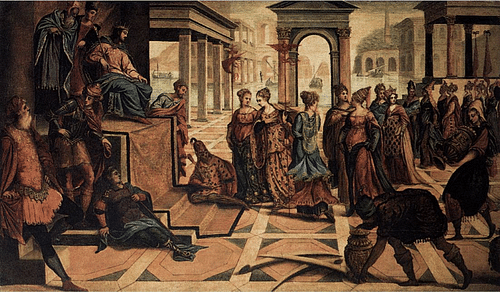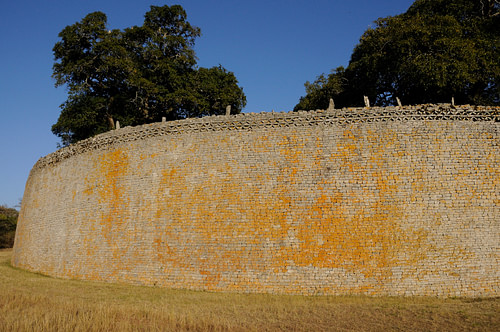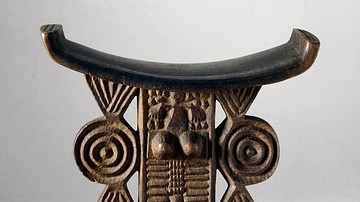Between 850 BCE and 1600 CE, great civilizations thrived in Africa, yet few non-Africans have learned about them. While some may be familiar with the achievements of ancient Egypt, most of our knowledge of African history is tainted by the legacy of colonialism, racism and prejudice. As Europeans engaged in the scramble for Africa between the 17th and 19th centuries CE, they established systems that disrupted the oral traditions that preserved Africa's history, and they created their own narratives that justified their occupation of Africa's lands and their enslavement of its people. To reinforce these narratives, some European historians and archaeologists ignored or manipulated the evidence of great African civilizations all around them. Their goal was to uncover proof of a lost white tribe whose time in Africa pre-dated the existence of black Africans, thus, establishing their rightful claim to the territories they were colonizing. The legacy of these endeavours is a series of stereotypes and misunderstandings about the continent and its people, including the erroneous belief that Africans have no history.
While great strides have been made to uncover the true history of Africa, the impact of colonial prejudice still lingers. Some of the clearest illustrations of this impact can be found when we examine the ruins of Great Zimbabwe, and the historians, archaeologists, explorers and colonialists who tried to deny its true history.

Today, the ruins of Great Zimbabwe are a UNESCO World Heritage Site and an important symbol of the history of the modern nation of Zimbabwe. Located on a high plateau between the Limpopo River in the south and the Zambezi River in the north, the stone ruins include a palace, a cone-shaped tower and several circular enclosures. The original builders, the ancestors of the Shona people, carved the stone bricks so expertly that they did not need to use mortar. The ruins are largely intact, and they have been isolated from the modern-day threats of pollution and urbanization. The location still has spiritual significance for the Shona, and some of the ruins still play a role in religious ceremonies.
The True History of Great Zimbabwe
It is believed that Great Zimbabwe was originally the capital of a powerful and prosperous kingdom. The structures that make up the ruins were likely built between the 11th and 15th century CE by the Shona, a Bantu-speaking tribe that originally migrated to southern Africa in the 2nd century CE.
The kings of Great Zimbabwe controlled thousands of kilometres of territory, but they did not conquer their lands with a massive army. The king of Great Zimbabwe received his authority to govern from his special connection to the spirits of deceased rulers, who offered him guidance. This mystical link to the ancestors allowed him to exert spiritual control over the rulers of smaller settlements in the area.
The king was also responsible for providing food for his people. He owned thousands of cattle and likely oversaw the storage and distribution of surplus grain. Some scholars believe that Great Zimbabwe's famed conical tower was a symbolic grain storage bin, and, thus, a reminder of the king's role in the survival of the entire community.

During the dry season, Great Zimbabwe's farmers became gold miners, and this gold contributed greatly to the prosperity of the empire. Along with ivory, it was one of Great Zimbabwe's major trade items. Through the Swahili trading ports on Africa's east coast, Great Zimbabwe obtained goods from all over the world. A great deal of evidence found at the site helps to prove Great Zimbabwe's connection to this global trade network. Archaeologists have uncovered a 14th century CE Arab coin, some 13th century CE Persian pottery and both porcelain and glass beads from China's Ming Dynasty.
Unfortunately, during the colonial period, much of the evidence of Great Zimbabwe's successful trade networks was manipulated to support theories that a Caucasian civilization had built the site. The presence of Arab coins and Persian pottery was used to attribute the site to Arab builders, not native Africans. Further twisting the true history of the site, the earliest written records about Great Zimbabwe were written in the 16th century CE, long after the site was abandoned, and most of these documents were written by Europeans who had little interest in accurately preserving the history of African civilization.
Karl Mauch & the Queen of Sheba
Karl Mauch (first name sometimes spelled Carl) was a German explorer and geologist who was searching for gold and precious stones when he first encountered the ruins in 1871 CE. Mauch's prejudices influenced his theories about the ruins. He did not believe it was possible for native Africans to build such sophisticated structures. In his journals, he claimed that the local Africans he had spoken to had only lived in the area for about 40 years, and that they were all quite “convinced that white people once inhabited the region” (Mauch, qtd. in Africa: A History Denied).
These journals are also filled with drawings of artifacts that he found at the site. An examination of these drawings shows that the objects are African in origin, yet Mauch never acknowledged this fact. Instead, he made every effort to link the ruins to characters from the Bible. He believed he had found the city of Ophir, a wealthy trading post or port city mentioned in the Bible, and he believed the ruins had once been the palace of the city's legendary ruler, the Queen of Sheba. According to the Biblical narrative, the Queen of Sheba came from a land of great wealth, and when she visited King Solomon in Jerusalem, she brought him valuable gifts, including gold, spices and precious gems.

Mauch had little evidence to support this theory. While exploring the site, he discovered some cedar beams that he assumed were from Lebanon. He concluded that only Phoenician traders could have supplied this material, which had also been used to construct Solomon's palaces. He then theorized that the Queen of Sheba had raised the stone structures in an imitation of Solomon's palace in Jerusalem.
While there was little physical evidence or documentation to support Mauch's theory, his speculations were supported by white colonialists who were busy claiming lands in the area for the British Empire. They accepted the false narrative because it provided a link between European civilization and the territories that they were appropriating.
Theodore Bent, Richard Hall & the Phoenicians
By 1891 CE, the ruins of Great Zimbabwe were part of the territory administered by the British South Africa Company, later to become Southern Rhodesia and then Rhodesia, named for its founder Cecil Rhodes. At this time, Theodore Bent, an archaeologist, was placed in charge of the site. Leading an expedition of the Royal Geographic Society and the British Association for the Advancement of Science, Bent came across some stone bird carvings that he felt were similar to artifacts he had seen when studying Near Eastern and Mediterranean civilizations. This inadequate evidence led Bent to conclude that the site had been built by Phoenicians, and that Africans had only moved in once the Phoenicians had abandoned the place.
This theory was one of many that the British colonialists accepted and promoted in order to justify white claims to African lands. Later theories would see the site attributed to ancient Egyptians, shipwrecked Vikings and even the mythological inhabitants of Atlantis.

In 1902 CE, Rhodes hired archaeologist and journalist Richard Hall to examine and preserve the site. Hall soon published a book, The Ancient Ruins of Rhodesia, that discussed his findings. In the book, Hall asserted that Great Zimbabwe had been constructed by “more civilized races” (quoted in Ampim, par. 4). Hall then began a period of “restoration” that removed layers of sediment up to two metres deep throughout the site with the goal of removing “the filth and decadence of [African] occupation” (ibid). In the process, he destroyed much of the archaeological record that could have conclusively proven the African origins of the site.
Gertrude Caton-Thompson's Use of Stratigraphy
Many of those allowed to investigate the site during the early 20th century CE were little more than treasure hunters who destroyed valuable evidence in their pursuit of gold artifacts and other luxuries. Their actions would make properly dating and studying the site more difficult for later historians and archaeologists. One of those who struggled to uncover the truth due to this legacy of destruction was Gertrude Caton-Thompson, a pioneer in modern archaeology who studied the site on behalf of the British Association for the Advancement of Science.
Caton-Thompson believed that earlier theories about the site were ludicrous. She intended to be far more careful and deliberate in her examination of the ruins. She used stratigraphy, one of the primary techniques of modern archaeology, to more accurately date her findings, but she had difficulty at Great Zimbabwe because so much evidence had been destroyed by her predecessors. She decided to use a plane to find unpillaged ruins and managed to locate a new set of walled enclosures that allowed her to date the site and to tear down the erroneous theories of Mauch, Bent and Hall.
The evidence she uncovered indicated that the site was far younger than previously believed, so it was not possible to link it to ancient Biblical figures or civilizations. In her book, Zimbabwe Culture, she concluded that the site was built during the medieval period by a native African civilization of “originality and amazing industry” (quoted in Hall and Stefoff, 17). She also argued that any artifacts that could be linked to non-African civilizations were evidence of trading relationships and not proof that a Near Eastern or Arab civilization constructed the site.
Despite her efforts to attribute the site to its true builders, Caton-Thompson's theories were also clearly influenced by racism. One piece of evidence that she used to support her findings was the circular structure of the ruins. She believed this proved the African origin of the site because the local people also used circular designs in constructing their homes and villages. Then, letting her prejudice show, she added that if a more advanced civilization had built the site, they would have built walls and buildings using straight lines and right angles.
Keith Robinson Uses Radiocarbon Dating
In 1958 CE, archaeologist Keith Robinson began using radiocarbon dating to date some wooden poles that he found during an excavation at Great Zimbabwe. His tests determined that the wood came from a tree cut down between 915 and 1215 CE, confirming Caton-Thompson's theory that the site was built in medieval times. Later scholars cross-checked Robinson's finds with other radiocarbon samples taken from the site and concluded that most of the buildings were constructed at the height of the Great Zimbabwe civilization between 1300 and 1450 CE.

The Legacy of False History Continues
While Robinson and Caton-Thompson's findings should have put an end to earlier theories that Great Zimbabwe was built by a lost white civilization, myths about its history persisted, motivated by racial bias and the continued desire to justify European colonization.
In 1965 CE, Southern Rhodesia broke free of British rule under the leadership of Ian Smith, a white colonist who declared himself prime minister of the new nation. During this time, Smith continued to produce false narratives about the history of Great Zimbabwe. Tourist guides, for example, showed black Africans bowing submissively to the white visionaries who were credited with building the site's circular walls and grand palace.
In 1980 CE, native Zimbabweans overthrew Smith's government and gained their independence. They adopted the name Zimbabwe to connect themselves to their earlier history. The famous stone birds that Theodore Bent once used as “evidence” of the site's supposed Phoenician origins are now the national emblem of Zimbabwe, appearing on their flag, coats of arms and currency. The site is now widely believed to be the work of the ancestors of the Shona people, but the legacy of false history lives on. Even on UNESCO's website explaining Great Zimbabwe's importance as a World Heritage Site the ruins are described as “the capital of the Queen of Sheba, according to an age-old legend.” Perhaps offering some hope that the true history of Great Zimbabwe will one day be the only history we learn about, UNESCO does go on to discuss the true origins of the site and its importance as a “unique testimony to the Bantu civilization of the Shona between the 11th and 15th centuries.”
The impact of prejudice on the history of Great Zimbabwe is a clear example of how colonialism has tainted the study of African history. The proper study of Africa's civilizations and their history that gives full credit to native Africans for their achievements is an essential part of the decolonization process, and we all must make a greater effort to separate the truth from the biases that shaped a false narrative of African history for far too long.







